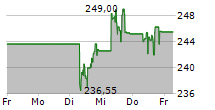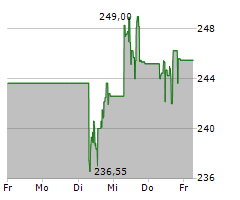- TED affects approximately 50,000 people in the UK.1 It is a frequently misdiagnosed and debilitating autoimmune condition that can lead to vision impairment, eye pain and changes in facial appearance2
- TED can reduce quality of life, impacting patient's mental wellbeing, confidence and ability to complete day-to-day tasks3
- Teprotumumab is the first immunotherapy to specifically target the insulin-like growth factor-1 receptor (IGF-1R), which is thought to play a key role in the development of TED4,5
- In the pivotal Phase 3 OPTIC clinical trial, 83% (34/41) of patients with active moderate-to-severe TED who were treated with teprotumumab demonstrated a reduction in proptosis (eye bulging) of at least 2mm, compared to 10% (4/42) of patients treated with placebo5
- Amgen will work with the National Institute for Health and Care Excellence (NICE) to seek reimbursement of teprotumumab for all eligible patients
Today, Amgen announced that the UK's Medicines and Healthcare products Regulatory Agency (MHRA) has granted marketing authorisation for TEPEZZA (teprotumumab) as the first therapy specifically licensed for the treatment of adult patients with moderate-to-severe Thyroid Eye Disease (TED).
Affecting approximately 50,000 people in the UK,1 TED is a progressive and potentially vision-threatening condition, which can cause eye bulging, double vision, eye pain, redness and swelling.2 People living with TED often experience anxiety and depression, concerns about their facial appearance and a loss of confidence.3 This can impact their ability to work, socialise and maintain relationships.3,6
"The marketing authorisation for teprotumumab as the first therapy specifically licensed for Thyroid Eye Disease (TED) in the UK marks a step forward for the patient community," said Dr Tony Patrikios, Executive Medical Director, Amgen UK Ireland. "TED can negatively affect patients' lives impacting vision, causing eye pain, making everyday tasks difficult and causing a loss of self-confidence. This authorisation introduces a new alternative treatment option and reinforces Amgen's commitment to supporting eligible patients with serious, underserved conditions."
Teprotumumab's marketing authorisation in the UK is supported by multiple clinical studies,5,7,8,9 including the Phase 3 clinical trial, OPTIC (n=83).5 Other clinical studies that supported the marketing authorisation in the UK include the TED01RV Phase 2 clinical study (n=88),7 the HZNP-TEP-403 Phase 4 clinical study (n=62),8 and the OPTIC-J Phase 3 study in Japan (n=54).9 In the OPTIC trial, teprotumumab demonstrated a statistically significant improvement in the primary endpoint, proptosis (eye bulging) responder rate at 24 weeks, with 83% (34/41) of patients demonstrating a reduction of at least 2mm compared to baseline, versus 10% (4/42) of patients treated with placebo (difference of 73%, 95% confidence interval, 59 to 88; P=<0.001]).5
"For adult patients living with Thyroid Eye Disease (TED), it can be challenging to receive a diagnosis and referral to specialist centres. TED is often mistaken for other more common conditions, which can be frustrating and distressing for patients. This may also lead to delays in receiving treatment. When patients are diagnosed with TED, they are currently faced with limited treatment options targeting 'generalised inflammation'. These treatments do not specifically target the underlying cause and drivers of TED," said Dr Jimmy Uddin, Consultant Ophthalmologist, Oculoplastic Orbital Surgeon, Moorfields Eye Hospital and St George's Hospital Medical School. "Teprotumumab offers eligible TED patients in the UK an important new treatment option."
The safety data for teprotumumab is based on multiple clinical studies.5,7,8,9 The most common side effects observed in clinical trials are muscle spasms (27.6%), diarrhoea (14.5%), hearing impairment (13.8%), alopecia (13.2%), hyperglycaemia (13.2%), fatigue (12.5%), nausea (10.5%), headache (10.5%), dry skin (9.9%), dysgeusia (8.6%), COVID-19 (6.6%), ear discomfort (6.6%) and nail disorder (5.9%).4
Amgen will work with the National Institute for Health and Care Excellence (NICE) to seek reimbursement of teprotumumab for all eligible patients.
This medicinal product is subject to additional monitoring. This will allow quick identification of new safety information. Healthcare professionals are asked to report any suspected adverse reactions.
Notes to Editors
About Thyroid Eye Disease (TED)
TED is a serious, progressive and potentially vision-threatening autoimmune disease.10 It often occurs in people living with Graves' disease, but is a distinct disease that is caused by autoantibodies activating an insulin-like growth factor-1 receptor (IGF-1R)-mediated signalling complex on cells within the retro-orbital space.11,12 This leads to a cascade of negative effects, which may cause long-term, irreversible damage, including blindness.13,14 Early signs and symptoms of TED may include dry eyes and grittiness; redness, swelling and excessive tearing; eyelid retraction; proptosis; pressure and/or pain behind the eyes; and double vision.2
About teprotumumab
Teprotumumab is a monoclonal antibody that specifically targets and blocks the insulin-like growth factor-1 receptor (IGF-1R), which is thought to play a central role in the development of TED.15 It binds to the IGF-1R, preventing it from being activated and sending signals that lead to muscle and tissue expansion, as well as inflammation behind the eye.15 This can help reduce TED symptoms, such as proptosis (eye bulging).4,5
For further product information, please see the Summary of Product Characteristics, which will be available at: https://www.medicines.org.uk/emc
About the Phase 3 OPTIC clinical trial
A prospective, multi-centre randomised, double-blind, placebo-controlled, Phase 3 trial of the IGF-1R inhibitor teprotumumab or placebo in adults with Graves' disease and active moderate-to-severe thyroid eye disease.5
83 patients between the ages of 18-80 were recruited and randomised 1:1 to receive 8 intravenous infusions of either teprotumumab or placebo. Infusions were administered every 3 weeks over 21 weeks, with a final clinical evaluation at week 24. The initial dose of teprotumumab was 10mg/kg, with each subsequent infusion dosed at 20mg/kg.5
The primary endpoint of the trial was proptosis response, defined as a reduction of at least 2mm in proptosis from baseline in the study eye without a corresponding increase of at least 2mm in the fellow (contra-lateral) eye at week 24.5
For more information on the OPTIC clinical trial go to: https://clinicaltrials.gov/study/NCT03298867.
About Amgen UK
Amgen's mission is to serve patients. A biotechnology innovator since 1980, our science- based heritage is at the heart of everything we do. We remain on the cutting edge of innovation, using technology and human genetic data to push beyond what is known today. In the UK, Amgen is advancing a broad and deep pipeline that builds on its existing portfolio of medicines to treat cancer, heart disease, osteoporosis, inflammatory diseases and rare diseases. As a regional hub, we employ around 650 people in the UK and Ireland across our commercial, R&D and corporate functions. Committed to driving sustainable solutions that can adapt to an ever-evolving health system, we are proud to serve patients every day.
For more information visit: https://www.amgen.co.uk/
References
1 British Thyroid Foundation. Thyroid eye disease. Available at: https://www.btf-thyroid.org/thyroid-eye-disease/1000. Last accessed: May 2025.
2 Royal National Institute of the Blind (RNIB). Thyroid eye disease. Available at: https://www.rnib.org.uk/your-eyes/eye-conditions-az/thyroid-eye-disease/#:~:text=It%20is%20well%20known%20that,be%20taking%2C%20such%20as%20steroids. Last accessed: May 2025.
3 Smith TJ, et al. How patients experience thyroid eye disease. Front. Endocrinol. 2023;9(14):1283374.
4 TEPEZZA (teprotumumab) Summary of Product Characteristics. Will be available at: https://www.medicines.org.uk/emc
5 Douglas RS, et al. Teprotumumab for the Treatment of Active Thyroid Eye Disease. N Engl J Med 2020;382:341-352.
6 British Thyroid Foundation. Thyroid eye disease: patient leaflet. Available at: https://www.btf-thyroid.org/thyroid-eye-disease-leaflet#:~:text=You%20may%20also%20feel%20anger,both%20social%20and%20at%20work. Last accessed: May 2025.
7 Smith TJ, et al. Teprotumumab for Thyroid-Associated Ophthalmopathy. N Engl J Med 2017;376:1748-1761.
8 Douglas RS, et al. Efficacy and Safety of Teprotumumab in Patients with Thyroid Eye Disease of Long Duration and Low Disease Activity. JCEM 2024;109(1):25-235.
9 Hiromatsu Y, et al. A randomised, double-masked, placebo-controlled trial evaluating the efficacy and safety of teprotumumab for active thyroid eye disease in Japanese patients. Lancet Reg Health West Pac. 2025;55:101464.
10 Ponto KA, et al. Quality of life and occupational disability in endocrine orbitopathy. Dtsch Arztebl Int. 2009;106(17):283-289.
11 Weightman DR, et al. Autoantibodies to IGF-1 Binding Sites in Thyroid Associated Ophthalmopathy. Autoimmunity. 1993;16(4):251-257.
12 Pritchard J, et al. Immunoglobulin Activation of T Cell Chemoattractant Expression in Fibroblasts from Patients with Graves' Disease Is Mediated Through the Insulin-Like Growth Factor 1 Receptor Pathway. J Immunol. 2003;170:6348-6354.
13 McKeag D, et al. Clinical features of dysthyroid optic neuropathy: a European Group on Graves' Orbitopathy (EUGOGO survey. Br J Ophthalmol. 2007;91:455-458.
14 Bartalena L, et al. The 2021 European Group on Graves' Orbitopathy (EUGOGO) Clinical Practice Guidelines for the Medical Management of Graves' Orbitopathy. Eur J Endocrinol. 2021;185(4):G43-G67.
15 Patel A, et al. A New Era in the Treatment of Thyroid Eye Disease. Am J Ophthalmol. 2019;208:281-288.
View source version on businesswire.com: https://www.businesswire.com/news/home/20250507246547/en/
Contacts:
Sejal Sachdev, Amgen UK Corporate Affairs
ssachd01@amgen.com




